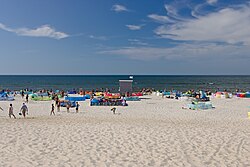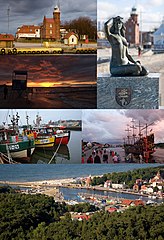

The Slowin Coast(Polish: Wybrzeże Słowińskie) is about 300 km long and part of the Polish Baltic coast between the mouth of the Persante in Kolbergwho have favourited the coast of the Treptow coast separates to the west, as well as the beginning of the Hel Peninsula at Wladyslawowo in the east and belongs to West Pomeranian Voivodeship and Pomeranian Voivodeship. In Poland it becomes the Koslin Coast counted.
places



_-_kutry_rybackie.JPG/250px-Dąbki_(zachodniopomorskie)_-_kutry_rybackie.JPG)



.jpg/250px-Gmina_Postomino,_Poland_-_panoramio_(5).jpg)







The main places on the coast are:
- 1 Kolberg
 (Kołobrzeg) - city center east of Parsęta
(Kołobrzeg) - city center east of Parsęta - 2 Darłowo

- 3 Ustka

- 4 Łeba

- 5 Wladyslawowo

Other places with access to the beach are from west to east:
- 6 Bagicz
- 7 Sianożęty
- 8 Ustronie Morskie

- 9 Pleśna
- 10 Gąski
- 11 Sarbinowo
- 12 Chłopy
- 13 Mielenko
- 14 Mielno

- 15 Unieście
- 16 Łazy
- 17 Dąbkowice
- 18 Dąbki

- 19 Bobolin
- 20 Darłówko
- 21 Wicie
- 22 Rusinowo
- 23 Jarosławiec
- 24 Jezierzany
- 25 Wicko Morskie
- 26 Górsko
- 27 Modlinek
- 28 Orzechowo
- 29 Poddąbie
- 30 Debina
- 31 Rowy
- 32 Rówek
- 33 Czołpino
- 34 Osetnik
- 35 Lubiatowo
- 36 Białogóra
- 37 Debki

- 38 Karwieńskie Błoto Drugie
- 39 Karwia
- 40 Ostrowo
- 41 Jastrzębia Góra
- 42 Rozewie
- 43 Chłapowo
Beach lakes
On the coast there are numerous beach lakes that are available for water sports outside of the nature reserves.
- 1 Sarbsko
- 2 Łebsko
- 3 Jezioro Dołgie Wielkie
- 4 Jezioro Dołgie Małe
- 5 Jezioro Gardno
- 6 Wicko
- 7 Bukowo
- 8 Jamno
- 9 Kopań
Lighthouses
There are eight lighthouses with viewing platforms on the coast:
- 10 Kołobrzeg lighthouse
- 11 Gąski lighthouse
- 12 Darłówko lighthouse
- 13 Jarosławiec lighthouse
- 14 Ustka lighthouse
- 15 Czołpino lighthouse
- 16 Stilo lighthouse
- 17 Rozewie lighthouse
Other goals
background
The Slovincian coast is located in northern Poland. It is due to the Vistula glaciation through glaciers, rivers (Parsęta, Wieprza, Słupia, Łeba, Piaśnica), Wind and ocean currents. There are shifting dunes (Lontzkedüne (Wydma Łąck) - 42 meters above sea level), beach lakes, moraines, cliffs and river deltas. In contrast, there are no significant tides and therefore no Wadden Sea.
language
In Poland, Polish is the official and national language. One gets along well with English in Poland. Often menus and information boards are also in German.
getting there
By plane
The most important airports in the region are Gdansk Lech Walesa Airport![]() (IATA: GDN) and Szczecin-Goleniów Airport
(IATA: GDN) and Szczecin-Goleniów Airport![]() (IATA: SZZ). As of 2019, the former will also be served by Ryanair, Wizzair, EasyJet, Lufthansa and Swiss from many German-speaking airports (Berlin, Bremen, Dortmund, Frankfurt, Cologne-Bonn, Munich, Vienna, Zurich). Immediately at the Baltic Sea stand in Bagicz at Kolberg there is another civil airport IATA code: EPKG, which is currently being expanded for scheduled flights. The airport is also used to travel to the region Poznan Lawica Airport
(IATA: SZZ). As of 2019, the former will also be served by Ryanair, Wizzair, EasyJet, Lufthansa and Swiss from many German-speaking airports (Berlin, Bremen, Dortmund, Frankfurt, Cologne-Bonn, Munich, Vienna, Zurich). Immediately at the Baltic Sea stand in Bagicz at Kolberg there is another civil airport IATA code: EPKG, which is currently being expanded for scheduled flights. The airport is also used to travel to the region Poznan Lawica Airport![]() (IATA: POZ) suitable. Rental cars can be booked at all airports with the exception of Kolberg.
(IATA: POZ) suitable. Rental cars can be booked at all airports with the exception of Kolberg.
By train
The Slowinsian coast can be reached by train from Szczecin or Gdansk.
In the street
The Slowinsian coast can also be reached by car and long-distance bus from Szczecin-Danzig. South of the coast, the S6 expressway runs parallel to the coast.
By boat
The coast has five ports, some of which are the departure and destination points for ferries to / from Scandinavia.
By bicycle
Two long-distance cycle routes lead through the region: the Baltic Sea Cycle Route as well as the Iron Curtain Europe Cycle Route.
On foot
The European long-distance hiking trail E9 leads through the region.
mobility
The best way to get around the region is by car or bus. The train only goes to certain places.
The runs directly along the Slowinsian coast Baltic Sea Cycle Route (also designated as EuroVelo 10).
Tourist Attractions
activities
The Slowinsian coast is ideal for sunbathing and water sports on the beach.
kitchen
Due to the proximity to the open sea but also to inland waters, marine and freshwater fish are the main components of the regional cuisine. Forest fruits, mushrooms and game provide the dense coastal forests Pomerania and the Kashubia.
nightlife
Outside the summer season, nightlife is concentrated in the big cities. In summer, on the other hand, there is a lot going on everywhere.
security
The Baltic coast usually falls flat under water and there are hardly any tides or unpredictable currents. Bathing is therefore usually safe for families with children and swimming accidents are rare. When swimming accidents do occur, excessive alcohol or drug consumption is usually involved. However, if you follow the general bathing rules and do not go into the water when the waves are high, you have little to fear.
climate
There is a transitional climate between maritime and continental climates on the Slovinzian coast. The amount of precipitation is lower and the temperature fluctuations higher (warmer summers, colder winters) than on comparable coasts in Western Europe.
literature
See article on Polish Baltic coast.


.jpg/350px-Darlowo_rynek_(1).jpg)












.jpg/350px-Gmina_Postomino,_Poland_-_panoramio_(5).jpg)
.jpg/160px-Gmina_Postomino,_Poland_-_panoramio_(9).jpg)
.JPG/320px-Jaroslawiec_-_Lighthouse_-_latarnia_morska_2012_(3).JPG)


















.JPG/320px-POL_JEZIORO_GARDNO_DSC00257_(2).JPG)



.JPG/350px-POL_Jezioro_Kopan_(2).JPG)

.JPG/145px-Gąski,_latarnia_morska_(Aw58).JPG)









.JPG/350px-Poznań-Ławica_(widok_na_terminal).JPG)